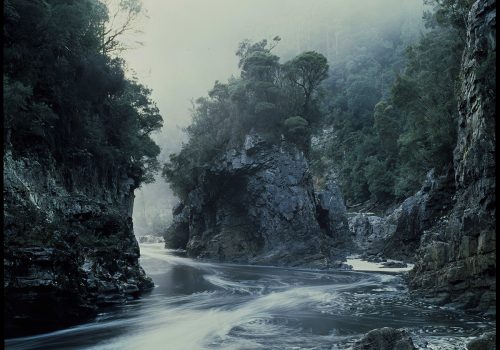By Alison Stieven-Taylor
As droughts last longer, bushfire seasons start earlier, rising seas threaten populations and ice caps melt, the climate emergency is indisputable, but often these crises are experienced at a distance. The exhibition Water at the Queensland Gallery of Modern Art (GOMA) brings these issues to the fore through narratives that convey impermanence, our interconnectedness and the challenges we face as a species.
This expansive exhibition, which includes more than 100 works by global artists, is designed to celebrate and question our conceptions of this precious, vital resource. Photography features alongside moving image, sculpture and several large installations that invite active participation.
Julian Charièrre
From a photographic perspective, there are works that are statements of protest, such as French-Swiss artist Julian Charièrre’s Blue Fossil Entropic series. Geraldine Kirrihi Barlow, Curatorial Manager, International Art, GOMA and the curator of Water, says, “As global temperatures rise and polar icecaps recede, Charrière asks what are we destroying of the past and what are we leaving for the future?” In this collection, Charièrre is photographed atop an iceberg, blowtorch in hand. A small, yet destructive figure, Charrière’s presence can be read as symbolic of the havoc that humans can visit on natural phenomena that have formed over aeons.
Peter Dombrovskis
The late Peter Dombrovskis’ photographs embrace the magic and majesty of the natural environment. The image Giant Kelp (1984) taken on Macquarie Island, a UNESCO World Heritage Site situated between New Zealand and Antarctica,conveys the otherworldly textures, hues and patterns found in nature. Dombrovskis images were also used in environmental campaigns, the most famous being Morning Mist, Rock Island Bend, Franklin River, Tasmania (1979) which was part of the successful movement to stop the damming of the Franklin River.
Bonita Ely
In another exemplar of protest, Water showcases the work of Australian Bonita Ely, an important figure in the environmental and feminist art movements. On display are images from her series Murray River Fieldwork (1977) and Murray River Project Continued (2007–9) which document the ongoing degradation of this river which is one of Australia’s major water sources.
Paul Blackmore
The exhibition features visual studies that explore our personal relationship with water too. Australian photographer Paul Blackmore spent more than four years documenting life in and under the water at Sydney’s iconic Bondi Beach for his series Heat, which is also a book. A selection of his underwater pictures from Heat are featured. Blackmore says, “For me, the act of immersing myself into the enormity of the ocean is like a secular baptism; a cleansing of the mind and body.”In these lyrical compositions, diffused shafts of sunlight break through the surface illuminating bodies as they rise in an effervescent swirl through the deep teal blue depths of the ocean.
Laurence Aberhart
For more than 30 years New Zealand photographer Laurence Aberhart has photographed the last light of day as the sun sets over the ocean. Aberhart shoots with a 19th century wooden-frame camera that uses 8×10” negatives. Each image requires a long exposure, sometimes hours, resulting in soft, diffused pictures where sea and sky become one, a blurring of the boundary between the earth and ether.
In viewing Water through these various photographic prisms, the significance of this essential resource to all forms of life on earth becomes so obvious as to render its continued abuse incomprehensible.
Water is the blockbuster show for Brisbane during the Australian summer.
7 December 2019 to 26 April, 2020.
Queensland Gallery of Modern Art
Stanley Place South Brisbane
https://www.qagoma.qld.gov.au/
















